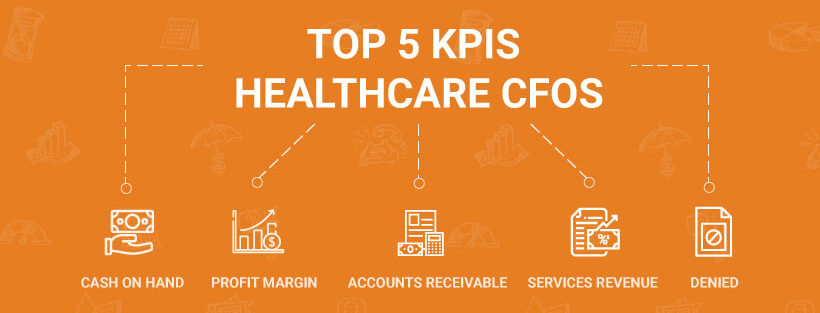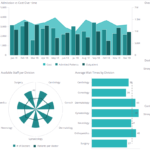Key performance indicators are metrics that help leaders and decision makers of the healthcare industry evaluate their organization’s performance and financial health. There are many metrics to look at for analyzing various departments of a healthcare organization but there are some key metrics or performance indicators that industry leaders use for evaluation. This blog aims to look at five such KPIs.
Key financial indicators help CFOs to compare their healthcare organization’s performance to other such organizations. ‘To effectively track healthcare revenue cycle performance, healthcare organizations should develop key performance indicators (KPIs)’, advises Sandra Wolfskill, Director of Healthcare Finance Policy and Revenue Cycle MAP at the Healthcare Financial Management Association (HFMA).She mentions in her article that some of the high-performing organizations have net days in AR between 28 and 36 days, whereas net days in A/R of 50 was considered a great number.
1. Days Cash On Hand
Days Cash on Hand is an indication of a hospital’s liquidity. How is it important in financial terms? An organization needs to have cash on hand to pay off lenders (if any) and to get good name from rating agencies; that’s all. According to Richard L. Gundling, vice president of healthcare financial management practices at the Healthcare Financial Management Association, “DCOH is just one of the things lenders and others look at”.
It’s good to have cash at hand when something goes wrong, but having too much is also an indication of improper use of resources. Good DCOH makes financial analysts feel good about an organization’s health for the time being but in order to have good DCOH in the future, it is important that we distribute our current resources to areas that can generate more revenue in the future. Here’s how you calculate Days Cash On Hand
(Total operating revenues) = (Cash and cash equivalents + Long-term investments) *365
2. Operating margin or operating profit margin percentage
Operating margin is one of the first key metrics an investor would look at to determine the profitability of a company. Operating margin is the amount of revenue a company makes after paying for all of it’s operational and overhead costs. Operating margin excludes taxes and interest paid on debts. Currently healthcare CFOs are looking for new ways to generate revenue as operating margins have declined across the healthcare industry.
A survey by Deloitte reveals that increased headcount costs, investments in clinical innovation and population health initiatives are three factors that are responsible for declining hospital costs other than decreasing revenues and rising costs. Mergers, funding, acquisitions, shifting patients to outpatient services and new staffing models are seen as new ways to improve revenue streams.
(Total operating revenues) = (Total operating revenues – Total operating expenses) *100
3. Net days in Accounts Receivable
Days in Accounts Receivable is the average number of days a practice takes to collect its payments. Net days in A/R shows a healthcare organization it’s revenue cycle efficiency. Net days in A/R is calculated by dividing net A/R by Average daily net patient service revenue. Days in AR can range from 30 days to 90 days or even more but be having a number less than 30 is the goal. The faster the returns the better an organization is doing at generating revenue.
One way of managing AR is by using a tool that can automate and enable smooth workflow. A tool that can categorize AR according to its age, it can assign AR follow up work to concerned team members. It keeps all teams belonging to the AR department to work in a synchronized manner. It can analyze performance and productivity of individual team members and groups. It can generate metrics like net days in AR for key decision makers like CFO, practice manager, etc.
Net A/R = Average daily net patient service revenue
4. Cash Collection as a percentage of net patient services revenue
The idea of using this KPI is to determine whether an organization’s revenue cycle has the possibility to convert net patient services revenue into cash. Total collected patient service cash divided by average monthly net patient service revenue gives Cash Collection as a percentage of net patient services revenue.
The ultimate goal here is to evaluate an organization’s financial health. The total patient service cash is the amount posted to patients’ accounts.
Total patient service cash collected = Average monthly net patient service revenue
5. Claims denial rate
This KPI is purely meant to evaluate whether the payer you are working with makes accurate reimbursements apart from adhering to the contract signed between you two. Claims denial rate is derived as a percentage of claims denied. The total number of claims denied divided by the aggregate number of claims remitted gives Claim Denial rate.
Claims denial cannot be avoided but a mismanagement of denied claims means lost revenue. If you are a provider treating patients in hundreds you really know how much money you could be losing. To tackle this problem, hospitals can use a tool that is specially designed to manage denials. This tool helps various teams within the denials department to be on the same page. For example, a person from the follow-up team needn’t call the concerned payer about a denial if his system shows that this denial has been reversed. It measures the performance of staff and their efficiency in reversing denials.It looks for patterns in claims denial like payer repeatedly rejecting claims for a particular reason. Denials assigned to teams, denials belonging to a payer group are some of the ways in which this tool can group denials for convenient analysis.
Total number of claims denied = Total number of claims remitted
We have discussed, the most commonly used KPIs in this blog but there are more. We will discuss more KPIs in the next blog. Please check out for blog page for more info.
Thanks for reading!






